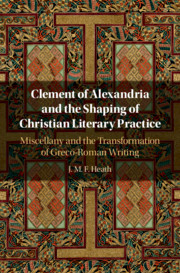 Clement of Alexandria and the Shaping of Christian Literary Practice
Clement of Alexandria and the Shaping of Christian Literary Practice Book contents
- Clement of Alexandria and the Shaping of Christian Literary Practice
- Clement of Alexandria and the Shaping of Christian Literary Practice
- Copyright page
- Contents
- Acknowledgements
- 1 Introduction
- 2 Clement’s Miscellanism and the Scholarly Trope of Christian Difference
- 3 Studying Ancient Miscellanism
- 4 Early Imperial Cultures of Miscellany-Making
- 5 Self-Introductions and Clement’s Miscellanistic Vocation
- 6 Miscellany Titles and Clement’s Divine Paratexts
- 7 The Miscellanist’s Trope of Deselecting Titles and Clement’s Conversion of Imagery
- 8 Muses in the Miscellanists’ Frame
- 9 Clement’s Theology of Hiddenness and the Logic of Christian Miscellanism
- 10 Mystery Initiation and Clement’s Literary Paideia
- 11 Poikilia
- 12 Conclusion
- Appendix The Literary Sequence of Protrepticus, Paedagogus, Stromateis (and Hypotyposeis)
- Bibliography
- Index
9 - Clement’s Theology of Hiddenness and the Logic of Christian Miscellanism
Published online by Cambridge University Press: 16 December 2020
- Clement of Alexandria and the Shaping of Christian Literary Practice
- Clement of Alexandria and the Shaping of Christian Literary Practice
- Copyright page
- Contents
- Acknowledgements
- 1 Introduction
- 2 Clement’s Miscellanism and the Scholarly Trope of Christian Difference
- 3 Studying Ancient Miscellanism
- 4 Early Imperial Cultures of Miscellany-Making
- 5 Self-Introductions and Clement’s Miscellanistic Vocation
- 6 Miscellany Titles and Clement’s Divine Paratexts
- 7 The Miscellanist’s Trope of Deselecting Titles and Clement’s Conversion of Imagery
- 8 Muses in the Miscellanists’ Frame
- 9 Clement’s Theology of Hiddenness and the Logic of Christian Miscellanism
- 10 Mystery Initiation and Clement’s Literary Paideia
- 11 Poikilia
- 12 Conclusion
- Appendix The Literary Sequence of Protrepticus, Paedagogus, Stromateis (and Hypotyposeis)
- Bibliography
- Index
Summary
Clement’s motif of concealment has often led scholars to describe him as an ‘esoteric author,’ who chose the miscellany genre in order to hide some things from some people, in imitation of scriptural concealment by aenigma. This chapter begins to respond by arguing that Clement’s esoteric tropes draw attention to the theme of hiddenness, which is a widespread imagistic discourse in his work. Five major modes of hiddenness are discerned in Clement’s theology: theological, anthropological, exegetical, social and cosmic; in practice, all of these are grounded in the hiddenness of God. God is transcendent, but is revealed in hidden ways in persons, texts, and in the world, for those who seclude themselves from the social gaze and direct their contemplation to God through Christ. Clement invites all people to participate in the divine economy of revelation with the selective discernment that is made possible by a gnostic relationship to the hidden God. Miscellanism emerges as the necessary and normative mode of gnostic life.
Keywords
- Type
- Chapter
- Information
- Clement of Alexandria and the Shaping of Christian Literary PracticeMiscellany and the Transformation of Greco-Roman Writing, pp. 239 - 270Publisher: Cambridge University PressPrint publication year: 2020


